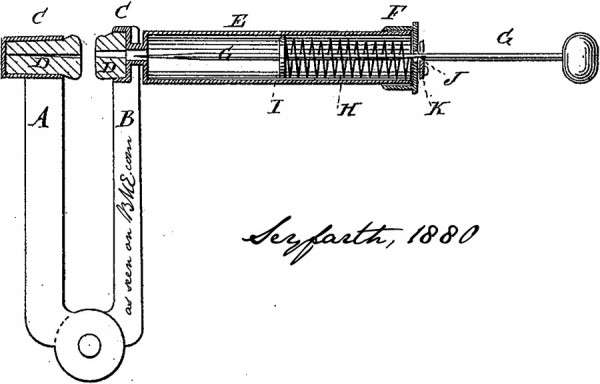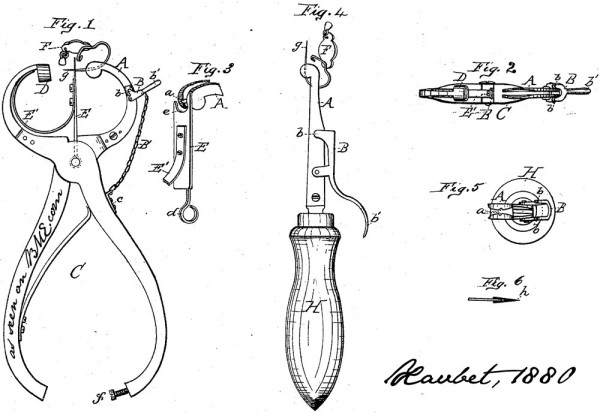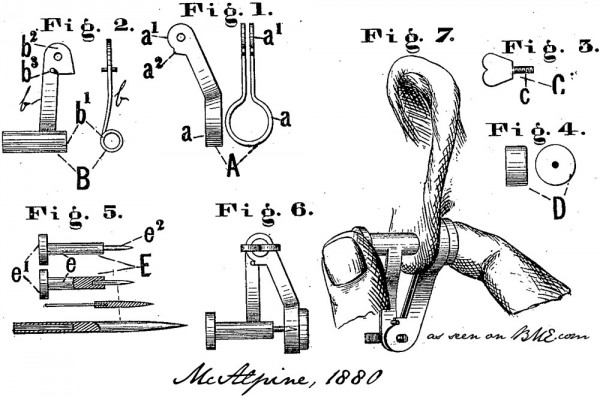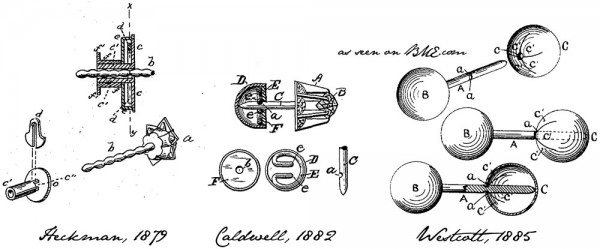This morning I was reading old patents (yes, this is what I do for entertainment) and came across an interesting one from way back the last time piercing was ?berpopular over 130 years ago ? filed May 10 and patented July 13, 1880 by Edward Seyfarth in Illinois (US Patent #240,073). As you can see, the design is not that much different from the piercing guns used by disease spreading hacks ^H^H^H^H nostril mutilating morons ^H^H^H^H I mean beauty salon ?piercers? even to this day. The patent application reads in part,
?Be it known that I, Edward Seyfarth, of Lanark, in the county of Carroll and State of Illinois, have invented a new and useful Improvement in Ear-Piercers ? The object of this invention is to furnish ear-piercers so constructed that the puncture can be made in exactly the desired spot and so quickly as to be painless ? The invention consists in constructing an ear-piercer of a pair of bars hinged to each other at one end and provided at their other ends with sockets to receive blocks to be pressed against the ear, the tube having a cap upon its outer end, the needle having a disk and a notch, the spiral spring, and the catch for holding the needle when drawn out, so that the ear may be pierced while being compressed.?
?In using the piercer the blocks (D) are placed upon the opposite sides of the lobe of the ear in such a position that the hole through the blocks (D) will be directly over the spot where it is desired to puncture the ear. The arms (A and B) are then pressed together to numb the part of the ear between the blocks (D). The catch (K) is then drawn back to release the needle (G), which is forced forward to make the puncture by the elasticity of the spring (H), thus making the puncture without causing pain. The needle (G) is then drawn back, the instrument is removed from the ear, and a wire or thread passed through the puncture in the usual way.?

I?ve often heard the urban myth that the ear piercing gun is directly based on or evolved from the tool that places tags in animal ears ? it wouldn?t surprise me if I?ve even written that at times. Even the extremely qualified and knowledgeable Elayne Angel says this in her recent book on the subject ?The Piercing Bible? (which reminds me, check out her excellent piercing blog at that link), writing ?these gadgets were originally invented for tagging cattle and other animals, and later adapted for use on humans?. But it seems this is a misleading statement, arguably false ? at best the two tools co-evolved. More likely when we?re talking about piercing tools of the ?gun? type that?s most common, one should more accurately argue the evolutionary process is actually the other way around, with a number of patents for animal tagging tools going to far as to explicitly refer back to this very ear-piercing gun patent by Edward Seyfarth! On the whole though I think it?s more realistic to say that the vast majority of animal tagging tools come from the same design family as modified pliers like riveting tools and leather punches, without that much overlap with the design of piercing guns (with a number of notable exceptions). But I?m beginning to digress.
Speaking of ear piercing guns that look more like animal tagging tools, there?s Francis X. Xavbet?s ?ear piercing pliers? filed December 3rd, 1880 (US Patent #250,121 issued November 29, 1881), a simple clamp-like device. Xavbet?s design, unlike Seyfarth?s which only creates the hole, uses sharpened jewelry to accomplish the process in a single step as the tool places the ring. His patent reads in part,
?The object I have in view is to produce simple and convenient means for piercing ears, in which the ear-ring itself can be used as the piercing-point, and will be released by the instrument when the hole is formed, so as to remain in the ear till healed.?
?The ear-ring (F) ? has a sharp-pointed wire (g). It is grasped by the clamp (A), in the position shown in Fig. 1, the plate (E) is then pushed toward the socket (D), and the lobe of the ear is introduced between such plate and the point of the ear-ring. The pliers are then forced together and the ear pierced, when the chain (B) draws back the dog (B) and the clamp is released. The instrument can now be removed from the ear and leave the ear-ring in position. The sharp point of the ear-ring can then be cut off; but this is not necessary, if the ear-ring is provided with a closed keeper, such as is used on safety pins.?
?When it is desired to place in the ears earrings not provided with sharpened points the removable cutting-points (h), Fig. 6, are used. These can be detached from the wires of the ear-rings after the holes are formed.?

I want to mention one other piercing tool that I dug up, filed just after the Seyfarth design by James McAlpine, on May 20, 1880 with the patent issued November 30th (US Patent #234,881). It deserves mention because it?s by far the simplest ? not much more than a holder to help shove a short needle through the lobe with your thumb ? he even suggests piercing both ears at once, as the tool is designed to be one-handed. The patent reads,
?The invention consists, mainly, in certain peculiarities of construction ? [a] means of which the instrument is adapted for use with one hand, in consequence of which it is possible, by applying an instrument to each ear and operating them simultaneously, to pierce both ears at the same time.?
?The operation is substantially as follows: The jaws having been opened, the set-screw being loose, the bearing-faces may be adjusted to the lobe of the ear, and then be held in the proper position simply by tightening the set-screw. By means of the stop projection and pin the jaws are prevented from being brought together too closely. An instrument being thus attached to each ear, as indicated in Fig. 7, and the piercers being inserted in the tubes, the operator, by means of his thumb and finger, simply presses the piercer toward the button, in consequence of which the lobe is pierced. The hands being used simultaneously, both ears are pierced at once.?
?Some of the advantages are as follows: The use of two instruments at once for simultaneous action is desirable, because, first, a saving of time is effected, and, second, the pain and difficulty resulting from two distinct operations are avoided.?

The above designs are some of the earliest piercing tools of their respective families that I have been able to find to date ? although I?m still searching and I strongly believe there are earlier ones in the patent archives that are still to be dug up. I don?t know for certain whether the first one is the earliest patent on a ?true piercing gun? and whether Mr. Seyfarth can be credited as the concept?s overall inventor (I doubt it), but it?s certainly very early and you can still see its influence in ear piercing guns in use around the world.
As you may have noticed from these three Victorian patents, at this point there wasn?t a standardized design for the initial jewelry such as the ubiquitous butterfly-back that is still common today. However, browsing other early patents you start to see hints of this line of thinking, and definite precursors of designs that are still in use. From left to right below are US patents 216,954 (filed May 1, 1879 by Lois Heckman), 269,383 (May 8, 1882 by John Caldwell), and 320,991 (May 1, 1885 by Charles Westcott) ? what is it with piercing inspiration and the month of May by the way?

All three of these designs use some variation on the backing lightly clamping into place on the bar, the first two being aesthetically closest to modern salon-style jewelry. The third one caught my eye though, because although it is functionally similar to the first two, visually it is identical to the barbell jewelry popularized in the body piercing world by Jim Ward in the 1970s?
When I have more time I will do additional patent research on this subject, both on the early history of body modification, and on some of the more recent patents, which have the advantage of being far more hilarious. For example, I was just reading a silly patent on a line of tongue piercing jewelry that contains a receptacle to release ?a substance such as a chemical, breath freshener, pleasant flavor, or medication into the mouth of a wearer? (US Patents 6,675,613 and 8,006,516). The concept works just as you?d expect ? a hollow bar to hold the substance, which is then released through holes in the beads. Anyone who has ever brushed plaque off of a tongue barbell can imagine just how disgusting this jewelry has the potential of becoming!!!
Source: http://news.bme.com/2013/01/26/the-early-history-of-the-ear-piercing-gun/
st louis university mario manningham mario manningham williams syndrome hoya casa de mi padre corned beef and cabbage
